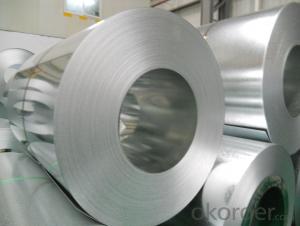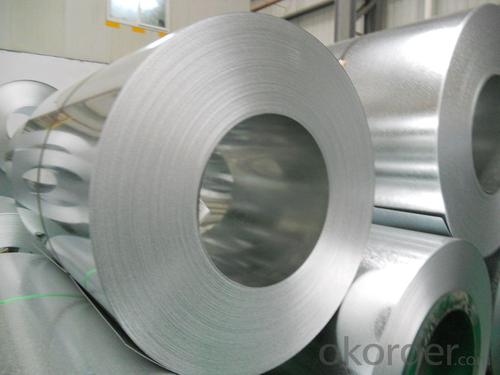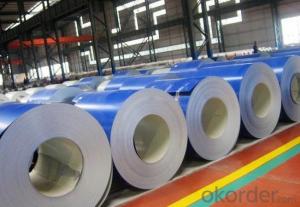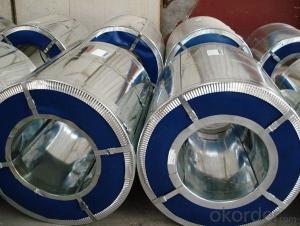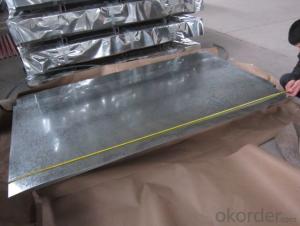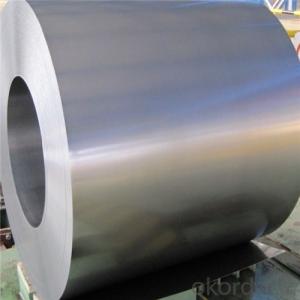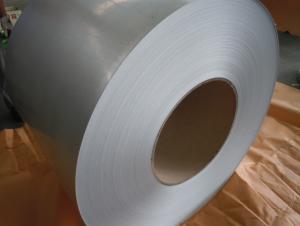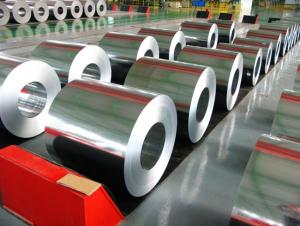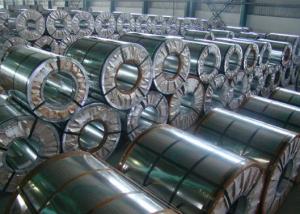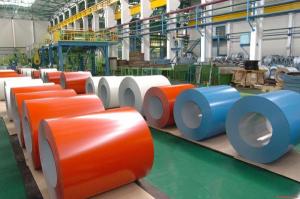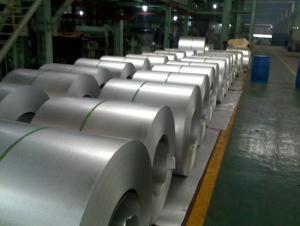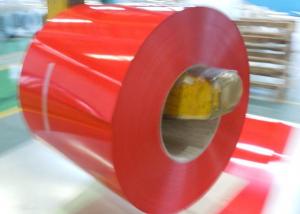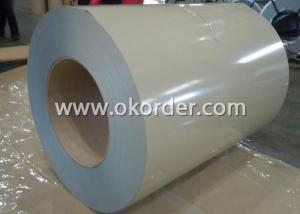Hot-dipped Galvanized Steel Coil in coils
- Loading Port:
- Shanghai
- Payment Terms:
- TT OR LC
- Min Order Qty:
- 25 m.t.
- Supply Capability:
- 2500 m.t./month
OKorder Service Pledge
OKorder Financial Service
You Might Also Like
Hot Dip Galvanized Steel in Coil
Description:
Galvanized Steel Coil gets coated in layers of zinc because rust won't attack this protective metal. The most external layer is all zinc, but successive layers are a mixture of zinc and iron, with an interior of pure steel. These multiple layers are responsible for the amazing property of the metal to withstand corrosion-inducing circumstances. Zinc also protects the steel by acting as a "sacrificial layer." If rust does take hold on the surface of Galvanized Steel Coil, the zinc will get corroded first. This allows the zinc that is spread over the breach or scratch to prevent rust from reaching the steel. For countless outdoor, marine, or industrial applications, Galvanized Steel Coil is an essential fabrication component.
Application:
With excellent cold bending molded manufacturablity, good decoration effect, strong anti-corrosion ability, galvanized steel coils and sheets are also pollution-free and easily recycled. Accordingly, they can be used as final products and basic plates of color coated steel coils and widely applied in construction, home appliances, decoration, ect.
Construction field ,ships building industry ,Petroleum and chemical industries ,war and electricity industries ,food processing and medical industry,boiler heat exchanger, machinery and hardware fields
Electial Appliance:refrigetator.washer,switch cabinet,etc
Furniture:central heating slice,lampshade,etc
Product Specification:
Material:SGCC,DX51D,Q195
Thickness: 0.3-3.0mm
Width: 600-1500mm
Inner Diameter: 508mm, 610mm
Weight of Steel Coil: 3-15MT
Coating Type: Al-Zn Alloy
Available Dipped Layer: 50-150g/m2
Surface Finish Structure: Normal Spangle & Small Spangle & Zero Spangle
Steel Grade:JIS G3302 SGCC
Spangle: normal spangle, large spangle, small(min) spangle, zero spangle
FAQ:
1.How about the package for the Coil?
Package:Covered with waterproof-paper,strapped by strips. Standard seaworthy export package:4 eye bands and 4 circumferential bands in steel, galvanized metal fluted rings on inner and outer edges, galvanized metal & waterproof paper wall protection disk, galvanized metal & waterproof paper around circumference and bore protection.
2. Can I know the production period of the goods?
Usually it need 20 days for 25tons in one container. We can produce 300 tons per day but we need to arrange the production in advance.
3. How about the label, could you make the label according to pour requirements?
Usually we use the MILL label, but if you need special form we can make.
- Q: In the game RuneScape, the concept of the fictitious metal, Rune has intrigued me. On an equal area AND weight basis (with a possible 10 lb exception) what metal is 256% stronger than steel?
- If you mean Mild steel which has a Ultimate Tensile Strength of 40 Kilograms/ sq.mm, there are many Heat-treated Alloy steels which are much stronger than this. For example, steels conforming to Grade-150-125, of ASTM A148 has a Ultimate Tensile Strength of 102 to 108 Kilograms/ sq.mm.
- Q: What is the standard width of steel coils?
- The standard width of steel coils varies depending on the specific industry and application, but it is commonly around 36 inches to 72 inches.
- Q: I need help! Please help, I'm in Chemistry, and me and my friend Lucy are making a presentation on steel and iron, so how is steel manufactured? Thank you. :D
- The steel consists of ( Iron ) and another matter... but the popular one is iron+carbon / iron+silver - When iron is smelted from its ore by commercial processes, it contains more carbon than is desirable. To become steel, it must be melted and reprocessed to reduce the carbon to the correct amount, at which point other elements can be added. This liquid is then continuously cast into long slabs or cast into ingots. Approximately 96% of steel is continuously cast, while only 4% is produced as cast steel ingots. The ingots are then heated in a soaking pit and hot rolled into slabs, blooms, or billets. Slabs are hot or cold rolled into sheet metal or plates. Billets are hot or cold rolled into bars, rods, and wire. Blooms are hot or cold rolled into structural steel, such as I-beams and rails. In modern foundries these processes often occur in one assembly line, with ore coming in and finished steel coming out. Sometimes after a steel's final rolling it is heat treated for strength, however this is relatively rare.
- Q: What are the factors influencing the price of steel coils?
- There are several factors that influence the price of steel coils. 1. Raw material costs: The price of steel coils is directly impacted by the cost of raw materials, such as iron ore and coal. Fluctuations in these commodity prices can greatly affect the overall price of steel coils. 2. Demand and supply: The supply and demand dynamics in the steel industry play a significant role in determining the price of steel coils. If there is a high demand for steel products, the price of steel coils is likely to increase. Conversely, if there is an oversupply of steel, prices may decrease. 3. Production and manufacturing costs: The cost of producing and manufacturing steel coils, including labor, energy, and transportation costs, can impact the final price of the product. Any changes in these costs can influence the overall price of steel coils. 4. Currency exchange rates: Steel is a global commodity, and its price can be influenced by fluctuations in currency exchange rates. If the currency in which steel is traded weakens against other currencies, it can result in higher prices for steel coils. 5. Government regulations and policies: Government regulations and policies, such as import tariffs, export restrictions, and environmental regulations, can impact the price of steel coils. These regulations can affect the cost of production and trade, ultimately influencing the price of steel coils. 6. Market competition: The level of competition among steel manufacturers and suppliers can also impact the price of steel coils. If there are multiple suppliers and manufacturers in the market, it can lead to competitive pricing, potentially driving down the price. On the other hand, if the market is dominated by a few suppliers, prices may be higher. It is important to note that these factors can vary over time and in different regions, ultimately affecting the pricing of steel coils in the market.
- Q: What are the common methods of slitting steel coils?
- There are several common methods of slitting steel coils, each with its own advantages and applications. 1. Rotary Shear Slitting: This method involves using rotary cutting knives to slit the steel coil. The coil is fed through the rotary shear machine, and the knives make simultaneous cuts along the length of the coil. Rotary shear slitting is known for its high-speed operation and ability to handle thicker gauge materials. 2. Loop Slitting: Loop slitting is a method where the steel coil is fed into a looping pit, creating a loop of material. The loop is then pulled through a set of knives that make the slits. This method is commonly used for thin gauge materials and provides precise cuts with minimal burr. 3. Drag Slitting: In drag slitting, the steel coil is fed through a set of driven rolls or drag pads, which help to maintain tension on the material. The coil is then guided through circular knives that make the slits. Drag slitting is suitable for various gauges of steel and offers good accuracy and edge quality. 4. Crush Slitting: Crush slitting involves passing the steel coil through a set of rolls, where one roll is rubber-covered and the other is hard. The rubber roll compresses the material against the hard roll, creating the slits. This method is commonly used for thin gauge or delicate materials as it minimizes the risk of edge damage. 5. Laser Slitting: Laser slitting utilizes a high-powered laser beam to make precise cuts on the steel coil. This method is highly accurate and allows for complex slitting patterns and narrow width cuts. Laser slitting is often used for high-end applications that require superior edge quality. Each of these methods has its own advantages and is chosen based on factors such as material thickness, desired edge quality, production speed, and cost considerations. It is important to carefully select the appropriate slitting method to ensure the desired outcome and efficiency in steel coil processing.
- Q: How are steel coils used in the production of automobile frames?
- Steel coils are an essential component in the production of automobile frames. These coils, made from high-quality steel, are first uncoiled and then fed into a stamping press where they are shaped into various parts of the frame. The steel coils provide the necessary strength and rigidity required to support the weight of the vehicle and ensure its structural integrity. Once the coils are stamped into the desired shape, they are often welded together to form the frame structure. This welding process helps to join the individual components securely, ensuring that the frame can withstand the forces and stresses encountered during the vehicle's operation. The use of steel coils in automobile frame production also allows for flexibility in design, as they can be easily shaped and manipulated to meet specific requirements. Furthermore, steel coils offer excellent durability and resistance to corrosion, making them ideal for automotive applications. The frames produced using these coils are strong, reliable, and able to withstand harsh conditions and road vibrations. This not only enhances the safety of the vehicle but also contributes to its longevity and overall performance. In addition to automobile frames, steel coils are also used in other critical components of the vehicle, such as suspension systems, chassis, and body panels. Their versatility, strength, and cost-effectiveness make them a preferred choice in the automotive industry. Overall, the utilization of steel coils in automobile frame production plays a significant role in ensuring the safety, durability, and performance of modern vehicles.
- Q: I have a necklace that has a pendent made out of stainless steel. The pendent is connected by a cord, not chain, that I can take on and off; so, I leave it on all the time. It has gotten pretty tarnished because of that.
- steel jewelry Daily care? Just need a soft cloth just fine. Or you can use toothpaste to clean the stailess steel jewelry.
- Q: How do steel coils contribute to sustainability in construction?
- Steel coils contribute to sustainability in construction in several ways. Firstly, steel is a highly durable material that has a long lifespan. Steel coils are used in the construction of various structural components like beams, columns, and frames, ensuring the stability and strength of buildings. By using steel coils, the resulting structures require less maintenance and have a longer service life, reducing the need for frequent repairs or replacements. This durability enhances the sustainability of construction projects by reducing the overall environmental impact associated with material waste and energy consumption. Secondly, steel is a highly recyclable material. Steel coils can be easily recycled and reused in new construction projects. The recycling process of steel has a significantly lower environmental impact compared to the production of new steel. Recycling steel coils helps to conserve natural resources, reduce the extraction of raw materials, and minimize energy consumption in steel production. By incorporating recycled steel coils into construction projects, the demand for new steel production is reduced, resulting in lower greenhouse gas emissions and a smaller carbon footprint. Furthermore, steel is a material that can be prefabricated off-site. This means that steel coils can be manufactured in factories in a controlled environment, minimizing construction waste and improving construction efficiency. Prefabricating steel coils reduces the amount of material waste generated on-site and decreases the need for transportation of construction materials, thereby reducing air pollution and energy consumption during construction. Additionally, steel is known for its high strength-to-weight ratio, which allows for lighter and more efficient structures. By using steel coils, construction projects can optimize the use of materials, resulting in reduced material consumption and lessening the overall environmental impact. The lightweight nature of steel coils also facilitates easier transportation, reducing fuel consumption and associated emissions during delivery. In summary, steel coils contribute to sustainability in construction through their durability, recyclability, prefabrication capabilities, and high strength-to-weight ratio. By utilizing steel coils, construction projects can minimize waste, conserve resources, reduce energy consumption, and decrease the environmental impact, ultimately promoting a more sustainable built environment.
- Q: How do steel coils contribute to the manufacturing of electrical equipment?
- Steel coils are used in the manufacturing of electrical equipment as they provide structural support and enhance the durability of various components. They are commonly used in transformers, motors, and generators, where they serve as the core material due to their magnetic properties. The steel coils help to create and maintain magnetic fields, ensuring efficient energy transfer and enhancing the overall performance of electrical equipment.
- Q: Why is the steel tape tape head not fixed?
- There are better tape measures, heads and magnets. For measuring steel objects, one can operate long distances.
Send your message to us
Hot-dipped Galvanized Steel Coil in coils
- Loading Port:
- Shanghai
- Payment Terms:
- TT OR LC
- Min Order Qty:
- 25 m.t.
- Supply Capability:
- 2500 m.t./month
OKorder Service Pledge
OKorder Financial Service
Similar products
Hot products
Hot Searches
Related keywords
